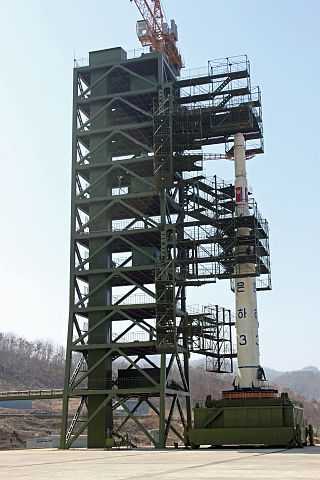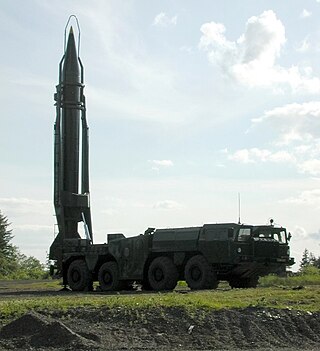- ↑ Also romanized from Korean script as Eunha under South Korea's Revised Romanization.
Related Research Articles

The Hwasong-7 is a single-stage, mobile liquid propellant medium-range ballistic missile developed by North Korea. Developed in the mid-1980s, it is a scaled-up adaptation of the Soviet R-17 Elbrus missiles, more commonly known by its NATO reporting name "Scud". The inventory is estimated to be around 200–300 missiles. US Air Force National Air and Space Intelligence Center estimates that as of June 2017 fewer than 100 launchers were operationally deployed.
The Kwangmyŏngsŏng program was a class of experimental satellites developed by North Korea. The name Kwangmyŏngsŏng is from a poem written by Kim Il Sung. The first class of satellites built by North Korea, the program started in the mid-1980s. There have been five launches so far, of which two have been successful.

The Tonghae Satellite Launching Ground(동해위성발사장), also known as Musudan-ri (Korean: 무수단리), is a rocket launching site in North Korea.

Taepodong-1 was the external designation given to a three-stage technology demonstrator developed by North Korea, a development step toward an intermediate-range ballistic missile. The missile was derived originally from the Scud rocket and was tested once in 1998 as a space launch vehicle. As a space launch vehicle, it was sometimes called the Paektusan 1.

Naro-1, previously designated the Korea Space Launch Vehicle or KSLV, was South Korea's first carrier rocket, and the first South Korean launch vehicle to achieve Earth orbit. On January 30, 2013, the third Naro-1 vehicle built successfully placed STSAT-2C into low Earth orbit.

The Taepodong-2 is a designation used to indicate what was initially believed to be a North Korean two- or three-stage ballistic missile design that is the successor to the Taepodong-1 technology demonstrator. In 2012, the U.S. Department of Defense assessed that the Taepodong-2 had not been deployed as a missile. The Taepodong-2 is the technology base for the Unha space launch vehicle, and was likely not intended as ICBM technology.

Two rounds of North Korean missile tests were conducted on July 5, 2006. The Democratic People's Republic of Korea reportedly fired at least seven separate missiles. These included one long-range Taepodong-2 missile and short-range Scud derived missiles including the enlarged Nodong missile. The Taepodong-2 was estimated by United States intelligence agencies as having a potential range reaching as far as Alaska, although this missile failed after about 42 seconds of flight.

The Korean People's Army Strategic Force, previously known as the Korean People's Army Strategic Rocket Force, is a military branch of the Korean People's Army (KPA) founded in 2012 that operates surface-to-surface missiles in the nuclear and conventional strike roles. It is mainly armed with ballistic missiles. The inventory includes domestic and Soviet designs.

Sohae Satellite Launching Station is a rocket launching site in Tongch'ang-ri, Cholsan County, North Pyongan Province, North Korea. The base is located among hills close to the northern border with China. The spaceport was built on the site of the village Pongdong-ri which was displaced during construction. It was the site for the 13 April 2012 launch of the North Korean satellite Kwangmyŏngsŏng-3, which was launched to celebrate the 100th anniversary of the birth of Kim Il-Sung. The rocket launch failed, but on 12 December of the same year Kwangmyŏngsŏng-3 Unit 2 was successfully launched and brought into Earth orbit.
The Korean Committee of Space Technology was the agency of the government of the Democratic People's Republic of Korea responsible for the country's space program. The agency was terminated and succeeded by the National Aerospace Development Administration in 2013 after the Law on Space Development was passed in the 7th session of the 12th Supreme People's Assembly.

Kwangmyŏngsŏng-1 was a satellite allegedly launched by North Korea on 31 August 1998. While the North Korean government claimed that the launch was successful, no objects were ever tracked in orbit from the launch, and outside North Korea it is considered to have been a failure. It was the first satellite to be launched as part of the Kwangmyŏngsŏng program, and the first satellite that North Korea attempted to launch.

The Hwasong-10, also known by the names BM-25 and Musudan, is a mobile intermediate-range ballistic missile developed by North Korea. Hwasong-10 was first revealed to the international community in a military parade on 10 October 2010 celebrating the Workers' Party of Korea's 65th anniversary, although experts believe these were mock-ups of the missile. Hwasong-10 resembles the shape of the Soviet Union's R-27 Zyb submarine-launched missile, but is slightly longer. It is based on the R-27, which uses a 4D10 engine propelled by unsymmetrical dimethylhydrazine (UDMH) and nitrogen tetroxide (NTO). These propellants are much more advanced than the kerosene compounds used in North Korea's Scuds and Nodong missiles.

A Scud missile is one of a series of tactical ballistic missiles developed by the Soviet Union during the Cold War. It was exported widely to both Second and Third World countries. The term comes from the NATO reporting name attached to the missile by Western intelligence agencies. The Russian names for the missile are the R-11, and the R-17Elbrus. The name Scud has been widely used to refer to these missiles and the wide variety of derivative variants developed in other countries based on the Soviet design.
The North Korean space program is the program of North Korea to develop its space capabilities.
Kwangmyŏngsŏng-3 Unit 2 was the first satellite successfully launched from North Korea, an Earth observation spacecraft that was launched on 12 December 2012, 00:49 UTC, in order to replace the original Kwangmyŏngsŏng-3, which failed to reach orbit on 13 April 2012. The United Nations Security Council condemned the satellite launch, regarding it as a violation of the ban on North Korean ballistic missile tests, as the rocket technology is the same.
The Hwasong-13, also known as Nodong-C or KN-08 under the U.S. naming convention, was a canceled North Korean road-mobile intercontinental ballistic missile believed to have been under development starting around 2012 until its cancelation in 2017. The changes shown in the mock-up displayed in October 2015 indicated a change from a three- to two-stage design.

The 2014 North Korean missile tests were a series of North Korean missile tests in 2014.

Kwangmyongsong-4 was a satellite launched by North Korea on 7 February 2016.

The Hwasong-17 is a North Korean two-stage ICBM, first unveiled on 10 October 2020, at the 75th anniversary of the founding of the Workers' Party of Korea (WPK) parade. The Japanese Ministry of Defence estimates its operational range at 15,000 km (9,300 mi) or more. Unlike its predecessors, the Hwasong-17 may be capable of carrying multiple warheads. North Korea claimed the first Hwasong-17 was successfully launched on 24 March 2022. Western analysts instead believe the 24 March launch was an earlier missile design, and a later test that took place on 18 November 2022 was the first successful test launch.

Chollima-1 is a North Korean launch vehicle. Chollima-1 will be used by North Korea to launch satellites into orbit. It is a three-stage rocket and the first stage is based on the Hwasong-17 ICBM. The rocket was launched from a coastal launch platform in the Sohae Satellite Launching Station. The rocket has been developed to compete with the South Korean Nuri rocket.
References
- 1 2 3 4 5 6 7 8 9 10 11 Brugge, Norbert. "Unha-3". Space Rockets Rest Of World. Retrieved 2025-01-11.
- ↑ "Status of North Korean Satellite unknown after prolonged Radio Silence, Reports of Tumbling – Spaceflight101". 12 February 2016. Archived from the original on 12 November 2019. Retrieved 30 December 2017.
- ↑ Krebs, Gunter. "Unha ("Taepodong-2")". Gunter's Space Page. Retrieved 19 April 2012.
- 1 2 3 4 5 6 7 8 9 David Wright (22 February 2013). "Markus Schiller's Analysis of North Korea's Unha-3 Launcher". All Things Nuclear. Union of Concerned Scientists. Archived from the original on 6 March 2013. Retrieved 7 March 2013.
- 1 2 3 4 5 6 David Wright (March 20, 2009). "An Analysis of North Korea's Unha-2 Launch Vehicle" (PDF). Union of Concerned Scientists. Archived from the original (PDF) on September 3, 2014. Retrieved January 23, 2013.
- ↑ Kim, Jack (2009-03-13). "FACTBOX: North Korea's Taepodong-2 long-range missile". Reuters. Retrieved 2009-03-30.
- ↑ "North Korea positions rocket for April liftoff". AP. 2009-03-27. Archived from the original on 2009-03-29. Retrieved 2009-03-28.
- ↑ "A post-launch examination of the Unha-2". 29 June 2009. Archived from the original on 23 March 2012. Retrieved 4 April 2012.
- ↑ "Unha-X".
- ↑ 朝鲜将发射"光明星二号"试验通讯卫星 (in Chinese). Xinhua. 2009-02-24. Archived from the original on February 27, 2009. Retrieved 2009-03-14.
- ↑ "North Korea fires long-range rocket: reports". The Sydney Morning Herald. 2009-04-05. Retrieved 2009-04-05.
- ↑ "Kim tours rocket launch area". The Straits Times. 2009-02-26. Retrieved 2009-03-14.
- ↑ "US Warns NK Not to Launch Rocket". The Korea Times. 2009-03-14. Retrieved 2009-03-14.
- ↑ "Russia urges North Korea to refrain from rocket launch". Asiaone News. 2009-03-27. Archived from the original on March 31, 2009. Retrieved 2009-03-28.
- ↑ "Defiant N Korea launches rocket". BBC News. April 5, 2009. Retrieved May 24, 2010.
- ↑ "NORAD and USNORTHCOM monitor North Korean launch" Archived 2012-10-17 at the Wayback Machine U.S. Northern Command News. April 5, 2009. Last accessed April 5, 2009.
- ↑ Sang-Hun, Choe; Cooper, Helene; Sanger, David E. (2009-04-06). "North Korea Seeks Political Gain From Rocket Launch". The New York Times. Retrieved 2009-04-07.
- ↑ Craig Covault (10 April 2009). "North Korean rocket flew further than earlier thought". Spaceflight Now. Retrieved 2009-04-17.
- ↑ "TEXT-N.Korea says it successfully launched satellite" Reuters UK 5 April 2009. Retrieved 30 June 2009.
- ↑ "North Korea carries out controversial rocket launch". CNN. December 12, 2012. Retrieved December 12, 2011.
- ↑ "North Korea Successfully Launches Satellite: Reports", SPACE.com, December 12, 2012 (accessed 24 Sept. 2014)
- ↑ "North Korea Long-Range Rocket Launch Fails: Reports". Space.com . 13 April 2012.
- ↑ "North Korea fires long-range rocket in defiant move, South Korea says". Fox News. 2012-12-11. Archived from the original on December 12, 2012. Retrieved 2012-12-11.
- ↑ "North Korea Delays Rocket Launch".
- ↑ "North Korea announces rocket launch date". Al-Jazeera. 2012-12-01. Retrieved 2012-12-01.
External links
- "An Analysis of North Korea's Unha-2 Launch Vehicle," Archived 2014-09-03 at the Wayback Machine David Wright, March 20, 2009.
- Robert S. Norris and Hans M. Kristensen, "Nuclear Notebook: North Korea's nuclear program, 2005", "Bulletin of the Atomic Scientists", May/June 2005.
 Unha-3 at launch pad in April 2012 | |
| Function | Expendable carrier rocket |
|---|---|
| Manufacturer | National Aerospace Development Administration |
| Country of origin | North Korea |
| Size | |
| Height | 28–30 metres (92–98 ft) [1] |
| Diameter | 2.4 metres (7 ft 10 in) |
| Mass | 86,750–91,000 kilograms (191,250–200,620 lb) |
| Stages | 3 |
| Capacity | |
| Payload to LEO | |
| Mass | 200 kg (440 lb) [2] (465 x 502 km) |
| Launch history | |
| Status | Active |
| Launch sites | Sohae, Tonghae |
| Total launches | 4 |
| Success(es) | 2 |
| Failure(s) | 2 |
| First flight | 5 April 2009 [3] |
| First stage | |
| Height | 15 m (49 ft) |
| Diameter | 2.4 m (7 ft 10 in) |
| Powered by | 4 Nodong 2-1 [4] [1] |
| Maximum thrust | 1192.8 kN [4] [1] |
| Specific impulse | 252 sec [5] [1] |
| Burn time | 120 seconds [5] [1] |
| Propellant | N2O4/UDMH [4] [1] |